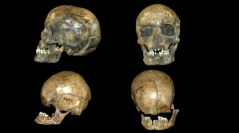

 Comptes Rendus Palevol
11 (2-3) - Pages 97-115
Comptes Rendus Palevol
11 (2-3) - Pages 97-115In February 1934, Jacques Fromaget of the Geological Service of Indochina discovered the Tam Hang rockshelter during prospecting work in Northern Laos. During his excavations, the geologist discovered seventeen anatomically modern human skulls. Ten of these skulls have been recovered in association with six largely-complete skeletons. These fossils, which are dated by 14 C to 15.7 ka, are used to address issues related to anatomical variation and migration in Southeast Asia during the Late Pleistocene. Excellent preservation of the skeletal material allows for estimation of body size and shape in a sample of young adults. Cranial metrics are also used to assess affiliations between Tam Hang and other Southeast Asian fossil samples in an effort to address questions about population migration. This fossil sample demonstrates that Late Pleistocene human activity may be productively addressed by continued work in the highlands of mainland Southeast Asia.
Human evolution, Mainland Southeast Asia, Late Pleistocene